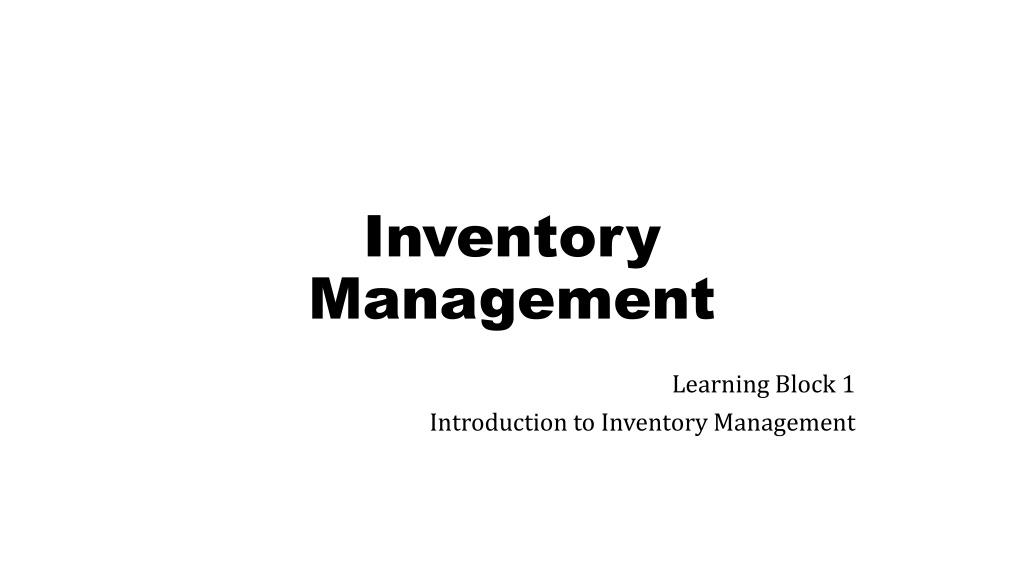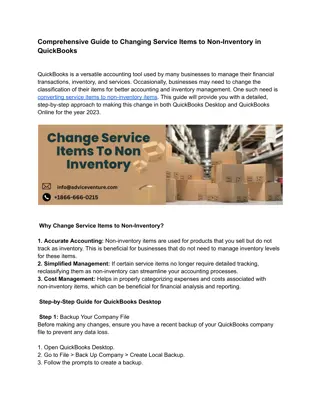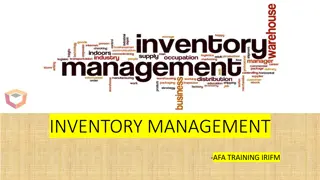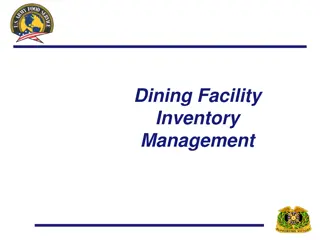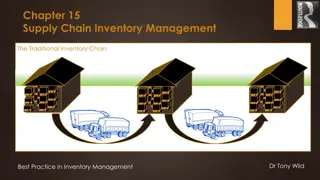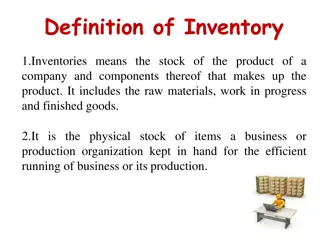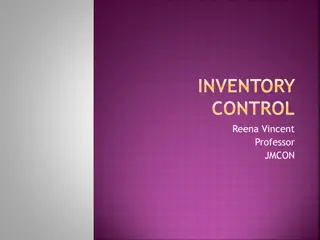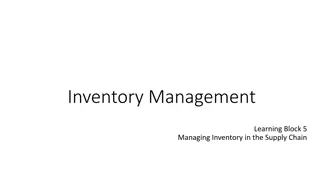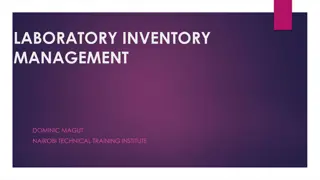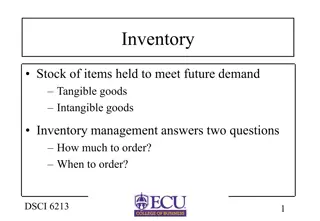Introduction to Inventory Management: Key Elements and Learning Block Agenda
Inventory management is crucial in supply chain operations, involving roles, costs, and benefits of inventories. This learning block covers essential topics like inventory control, forecasting, and financial implications. Key elements include techniques for managing inventory levels, types of inventory, and forecasting relationships. The course aims to prepare students for the Inventory Management certification exam. The agenda covers inventory importance, classification, and distribution center responsibilities.
Download Presentation

Please find below an Image/Link to download the presentation.
The content on the website is provided AS IS for your information and personal use only. It may not be sold, licensed, or shared on other websites without obtaining consent from the author. Download presentation by click this link. If you encounter any issues during the download, it is possible that the publisher has removed the file from their server.
E N D
Presentation Transcript
Inventory Management Learning Block 1 Introduction to Inventory Management
Abstract Inventory management is an important function in controlling assets in the supply chain. Individuals working in the supply chain should have at least a basic understanding of the roles, costs, and benefits of inventories. This certification track is intended to provide students with an understanding of the basics of inventory management and to enable effective contributions to an organization. Inventory is a function in the overall supply chain processes of an organization. Inventory is often obtained from suppliers in the form of raw materials and other goods and materials through the procurement department. Inventory also includes work in process and finished products from manufacturing operations. Key elements in this certification track include the importance and use of inventory in the supply chain, exposure to the different types of inventory, techniques for effectively managing and controlling inventory levels, the relationship between forecasting and inventory management, and the financial impacts of inventory investments. The goal of this certification track is to prepare students to pass the Inventory Management national certification examination. The content of the certification track was developed by LINCS in Supply Chain Management Consortium. SCPro Fundamentals Certification examinations are owned and administered by the Council of Supply Chain Management Professionals (CSCMP).
Course Agenda 1. Introduction to Inventory Management 2. Monitoring and Analyzing Inventory 3. Inventory Control 4. Inventory Management and Forecasting 5. Managing Inventory in the Supply Chain 6. Inventory Performance Measurement and Financial Implications 3
Learning Block Agenda Understand the role and importance of inventory Discuss the main reasons for carrying inventory Describe the main approaches to managing inventory Outline how inventory items can be classified Explain the key roles and responsibilities for managing inventory at distribution centers (DCs)
Description A function in the overall supply chain process of an organization Inventory is often obtained by suppliers in the form of raw materials and other goods and materials through the procurement department Inventory also includes work in the process and finished products from manufacturing operations
Key Elements Techniques for effectively managing and controlling inventory levels. The importance and use of inventory in the supply chain. Exposure to the different types of inventory. The relationship between forecasting and inventory management. Financial impacts of inventory assessment.
Learning Block 1: Introductory Learning Block 1: Introductory Management Management Companies are increasingly looking to provide improved customer service levels at reduced costs; the amount, type, and cost of inventory within a company has direct impacts on both service levels and the profitability associated with those service levels.
Unit 1: Inventory Basics
Unit 1: Inventory Basics Inventories may be found in: Inventory Includes: Raw Materials Work in Progress (WIP) Finished goods Merchandise Spare parts Other operating supplies Factories Warehouses Retail Stores Other type of storage facilities
Unit 1: Inventory Basics Ideally, an organization would have sufficient inventory to satisfy customer demands for products without losing any revenue due to insufficient stock. An organization does not want to have too much inventory on hand, because it costs too much money to both acquire and hold inventory. Greatest Challenges for managing inventories Balancing Supply and Demand
Unit 1: Inventory Basics Inventory management involves striking a balance between three classes of costs: Acquisition costs are incurred during purchase order (PO) preparation and processing and during receiving and inspecting purchase items Carrying costs are incurred in maintaining a stock of goods in storage Stockout costs (also called shortage costs) are incurred when an item is out of stock
Learning Block 1: Introductory Management Learning Block 1: Introductory Management Loss of Sales Equipment downtime due to the lack of spare parts A complete lack or limited amount of components and raw materials to assemble products Insufficient Inventory
Unit 1: Inventory Basics Acquisition Costs Include the purchase price paid and associated administrative costs. Costs associated with placing the PO for those materials or services, including the labor cost to create, review, and transmit the order. The labor costs to receive and pay for ordered items.
Unit 1: Inventory Basics Carrying Costs There are costs associated with carrying items, such as building like warehouses, utilities, systems to track inventory, and labor to manage those inventory tracking systems. Purchasing large quantities of product may require a form to utilize funds from loans or the issuance of stock. The cost of using borrowed funds
Unit 1: Inventory Basics Stockout Costs Lost Costumers Backorder Costs if costumers are not willing to wait for a backorder, they may decide to take their business elsewhere, leading to reduce revenue for the firm. These are incurred when a firm must place an order with its suppliers for a rush shipment to meet customers or internal manufacturing needs; rush shipments typically incur higher handling and transportation costs
The Necessity of Inventory Firms hold inventory to meet the needs of their customers Customers may be external to the firm of employees of other departments within the firm who requires a certain product, material, or part.
The Necessity of Inventory Firms hold inventories as means of dealing with uncertainty in the supply chain. This uncertainty comes from chronic supplier manufacturing delays late deliveries poor quality damaged and incorrect deliveries other issues that arise in the supply chain
Appropriate Reasons to Carry Inventory A manufacturing company requires inventory of raw materials and components to create finished products and meet its production and other schedules. Retailers could not operate without inventories of finished goods; without inventory, customers would be looking at empty shelves. Personnel throughout the supply chain need to manage inventory on a daily basis Ex. Retail store managers must know the exact number of items they carry on display and in storage to fill costumer orders, place orders when inventory is low, and control theft and losses due to error.
Problematic Reasons for Carrying Inventory Ordering inventory is often used to compensate for supply chain problems, which leads to excess inventory. Instead of addressing the root causes of problems, companies mask them with high inventories
Problematic Reasons for Carrying Inventory Examples of supply chain problems include Poor demand planning, poor forecasting, and high forecasting error Product theft Poor supplier performance (inaccurate lead time, late delivery, poor quality, etc.) Poor production yields that require greater inputs for the desired output Poor or non-existent inventory planning and tracking systems Poor inventory counting systems that reduce stock accuracy Large-quantity purchases to obtain lower unit prices that are outweighed by higher carrying costs Inattention to obsolete inventory disposition; obsolete stock no longer has value
Inventory Carrying Locations Inventories of raw materials, components, semi-finished products, maintenance items, and repair items are often held at supplier facilities or at the buying company s warehouse and other facilities. Inventories of finished or intermediate (semi-finished or processed) goods may be found at locations such as manufacturing facilities, warehouses, DC s (distribution centers), retail locations or point-of-sale (POS) locations.
Functional Types of Inventory Different types of inventory have unique functions or purposes and may be managed differently depending on where the inventory is held and its role in the supply chain. Cycle Stock In-process stock Safety tock Maintenance, Repair, and Operations (MRO) Inventory Seasonal stock Promotional stock Speculative stock (hedge stock)
Functional Types of Inventory Cycle stock: inventory that is depleted through normal use or sale; firms hold cycle stock in DC s and retail stores in anticipation of customer orders or to respond to normal consumption demands. In-process stock: good being manufactured or in between manufacturing processes (also known as WIP or semi-finished goods) Safety stock (buffer stock): Held to protect against uncertainties in the supply chain. These uncertainties include chronic supplier manufacturing delays, changes in demand rate (the rate of demand for stock that can vary over time), and variances in lead-time length.
Functional Types of Inventory Seasonal stock: Stock held in advance of the season when the firm expects to sell it. Industries that typically require significant seasonal stock include apparel, sporting goods, and specialty holiday. Promotional stock: Stock held to respond quickly to marketing promotions or price incentives a firm plans to offer its customers, including holiday promotions.
Functional Types of Inventory Speculative stock (hedge stock): most commonly associated with companies involved in manufacturing or assembly. This type of inventory is held to protect against expected and possible price increases or constrained availability.
Functional Types of Inventory Maintenance, Repair, and Operations (MRO) Inventory: Parts and materials that exist primarily to ensure a plant or manufacturing facility and its equipment are safe, reliable, and optimally available for production purposes. Service parts help ensure that key pieces of equipment continue to function effectively.
Unit 4: Managing Inventory Unit 4: Managing Inventory
Managing Inventory According to Scott (2015), inventory management is a means of controlling and managing the flow of products into, within, and out of an organization. Effective inventory management means using a variety of different inventory management tools and techniques (which is covered in Learning Block 2). The central goal of inventory management is to optimize levels of inventory so there is the right amount of inventory in place to meet customer needs, while ensuring the company is not overinvesting in inventory.
Managing Inventory Although the key principles of inventory management are the same across all industries, the areas that need to be emphasized vary from sector to sector. Key areas of responsibility for inventory management: Demand Planning Deciding How Much Inventory to Hold Counting Inventory Tracking and Controlling Inventory
Managing Inventory Demand Planning: A key element of inventory planning is to estimate the amount of inventory required over a set time period to meet customer needs. Various forecasting, planning tools, and techniques are used for demand planning and are covered in Learning Block 4. Accurate demand planning prevents both oversupply and undersupply of inventory.
Managing Inventory Deciding How Much Inventory to Hold: Rightsizing the inventory is dependent on the specific industry. Retailers may want a one- or two-month supply on hand, while food businesses will want to have much less inventory because of their products limited shelf life, especially fresh foods, to minimize loss and spoilage. Companies carrying maintenance spares may carry inventory for months or even years until demand arises. Several tools, techniques, and strategies exist for determining how much inventory to hold, which is outlined in Learning Block 2.
Managing Inventory Counting Inventory: For inventory control purposes, it is necessary to compare the on- hand levels with inventory records by performing a physical count of all items. Inventory counts are usually done either by counting the entire inventory at one time, known as a physical inventory, or by counting items at varying times on a prescheduled basis, which is called cycle counting (counting inventory is covered in Learning Block 3).
Managing Inventory Tracking and Controlling Inventory: Once a company has acquired inventory, suitable tracking and control methods must be implemented. Accurate tracking of inventory is essential to ensuring where inventory is in the supply chain, how much inventory is moving in and out of the company, and how much inventory is being held at any one point in time. Inventory control involves counting and monitoring inventory items, recording the stocking and retrieval of items, identifying and verifying storage locations, recording changes to inventory, and anticipating inventory needs (inventory control is covered in Learning Block 3).
Inventory Management/Control Employee Tasks Inventory management personnel classify, label, and maintain inventory and keep accurate inventory records, including the location of inventory for easy retrieval Management personnel communicate inventory locations and levels to department managers, and keep records of inventory for disposal or transfer (implementing a control system can help reduce breakage, damage, and obsolescence). Inventory control personnel may also be responsible for recording incoming inventory purchases and outgoing inventory types and quantities in the shipping and receiving department.
Inventory Management/Control Employee Tasks Companies also require physical inventory counts to help ensure accuracy of inventory. Through stock counts, inventory control employees must reconcile inventory records with physical inventory on-hand; this occurs either once a year, when stock is physically counted and compared to inventory records, or on an ongoing basis, using cycle counting.
Types od Jobs in Inventory Management Jobs and Key Duties in inventory management include: Inventory Control Analyst: Includes cycle counting and keeping records Inventory Data Analyst: Analyzes data and scenarios, evaluates options, and makes recommendations to management Inventory Operations Specialist: Includes product tracking and placement Quality assurance: Includes acceptance and inspection of incoming and outbound product Inventory Supervisor: Includes direct supervision of inventory control personnel
Inventory Management/Control Employee Tasks Depending on the size of the operation, Inventory control workers typically report to a supervisor. The supervisor typically reports to a warehouse manager or inventory manager, depending on the size of the organization and its structure. Warehouse managers may in turn report to a distribution director, while inventory managers may report to an inventory director. Inventory Supervisor Inventory Operations Specialist Quality Assurance Specialist Inventory Control Analyst Inventory Data Analyst
Practice Questions 1. Inventory can be defined as: a. Raw materials, work in process, finished goods, merchandise, spare parts and other operating supplies, which may be found in factories, warehouses, retail stores, or other types of facilities b. Only the finished goods in a store c. Only the goods purchased to supply customer needs d. Only the materials in a distribution center 2. What is one of the greatest challenges in managing inventory? a. Obtaining an accurate demand plan b. Carrying enough inventory to cover all emergencies c. Having a responsive procurement system d. Balancing service with demand
Practice Questions 3. Firms hold inventory for which reason? a. To meet the needs of shareholders b. To meet the needs of customers c. Firms do not need to hold inventory d. To reduce investment 4. Cycle stock is held ____________________. a. To protect against uncertainties in demand b. In advance of the season during which it will be needed c. For rapid response to marketing promotions d. To respond to normal demand or consumption
Practice Questions 5. Inventory management is a means of ____________________. a. Managing manufacturing operations b. Increasing the levels of inventory held throughout a company c. Controlling the flow of products into, within, and out of an organization d. Eliminating the purchase of inventory 6. Measuring inventory turnover involves ____________________. a. Counting and monitoring inventory b. Measuring the rate at which inventory moves through a facility c. Determining how much inventory to hold d. Counting all items at varying times on a prescheduled basis
Practice Questions 7. A key responsibility in inventory management is forecasting the amount of inventory that will be required over a(n) ____________________. a. Set period of time to meet customer needs b. Set period of time to meet some customer needs c. Set period of time to meet competitor needs d. Indefinite period of time to meet customer needs 8. The duties of an inventory management employee include ____________________. a. Maintaining high levels of stock at any cost b. Purchasing replenishment stock c. Physical inspection of all goods received d. Maintaining accurate and acceptable inventory levels
Practice Questions 9. Firms hold safety stock (buffer stock) for what reason? a. To protect against expected and possible price increases or constrained availability b. To have in advance of the season during which the stock will be needed c. To allow for a quick and effective response to a marketing promotion or price deal d. To protect against uncertainties in the supply chain 10. What types of industries require significant seasonal stock? a. Automotive and automotive after-market b. Wholesale and retail food c. Apparel, sporting goods, and specialty holiday d. Home improvement and construction
